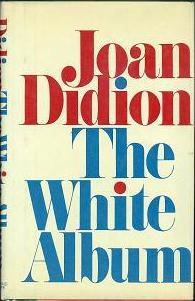

|
m Reverted edits by 216.125.91.130 (talk) identified as unconstructive (HG)
|
added Category:Books about California using HotCat
|
||
| Line 74: | Line 74: | ||
[[Category:1979 books]] |
[[Category:1979 books]] |
||
[[Category:Essay collections by Joan Didion]] |
[[Category:Essay collections by Joan Didion]] |
||
[[Category:Books about California]] |
|||

1st edition
| |
| Author | Joan Didion |
|---|---|
| Language | English |
| Genre | Essays |
| Publisher | Simon & Schuster |
Publication date | 1979 |
| Publication place | United States |
| Media type | Print (Hardback & Paperback) |
| Pages | 222 |
| ISBN | 0-671-22685-1 |
| OCLC | 23163086 |
The White Album is a 1979 book of essays by Joan Didion. The entire contents of this book are reprinted in Didion's We Tell Ourselves Stories in Order to Live: Collected Nonfiction (2006).
The White Album is an autobiographical literary essay detailing loosely related events in the author's life in the 1960s, primarily in Los Angeles, California. In the course of describing her ongoing psychological difficulties, Didion discusses Black Panther Party meetings, drug-related experiences, a Doors recording session, various other interactions with LA musicians and cultural figures and several prison meetings with Linda Kasabian, a former follower of Charles Manson who was testifying against the group for the grisly Sharon Tate murders. Tate had been an acquaintance of Didion's. The murder trial cast a cloud of fear over Hollywood that seemed to propel many of Didion's insights. The impression conveyed is one of a city and nation pervaded by paranoia and detachment.
However, the ending, in which the author moves away from what she feels to be the unstable world of Hollywood and renovates an old house that possesses a few lingering associations with the 1960s, indicates that for her there is still the possibility of escaping the paranoia and unrest of that decade.
The liberal Episcopalian bishop is viewed as representing the shallower aspects of American spirituality.
An account of a lavish Governor's mansion commissioned by Ronald Reagan, while Governor of California, which was not used.
The Museum is viewed as an extension of power
The contemporary workings of Caltrans.
Californian politics
A critical essay which views second-wave feminism as a Marxist substitute for the proletariat.
The author of The Golden Notebook is seen as a 'nativist' writer in the manner of Theodore Dreiser.